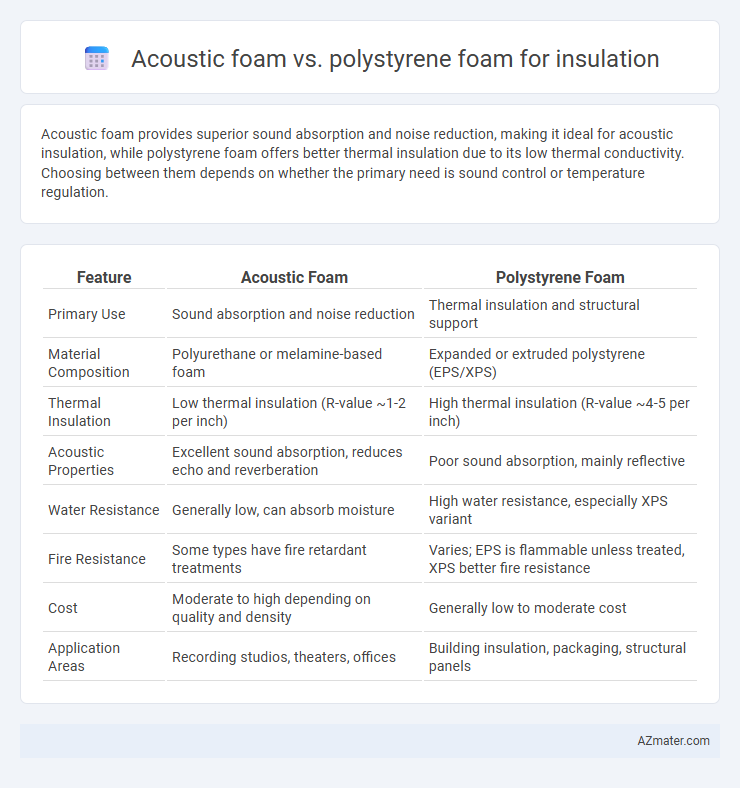Acoustic foam provides superior sound absorption and noise reduction, making it ideal for acoustic insulation, while polystyrene foam offers better thermal insulation due to its low thermal conductivity. Choosing between them depends on whether the primary need is sound control or temperature regulation.
Table of Comparison
| Feature | Acoustic Foam | Polystyrene Foam |
|---|---|---|
| Primary Use | Sound absorption and noise reduction | Thermal insulation and structural support |
| Material Composition | Polyurethane or melamine-based foam | Expanded or extruded polystyrene (EPS/XPS) |
| Thermal Insulation | Low thermal insulation (R-value ~1-2 per inch) | High thermal insulation (R-value ~4-5 per inch) |
| Acoustic Properties | Excellent sound absorption, reduces echo and reverberation | Poor sound absorption, mainly reflective |
| Water Resistance | Generally low, can absorb moisture | High water resistance, especially XPS variant |
| Fire Resistance | Some types have fire retardant treatments | Varies; EPS is flammable unless treated, XPS better fire resistance |
| Cost | Moderate to high depending on quality and density | Generally low to moderate cost |
| Application Areas | Recording studios, theaters, offices | Building insulation, packaging, structural panels |
Introduction to Acoustic Foam and Polystyrene Foam
Acoustic foam is engineered to absorb sound waves and reduce noise, featuring a porous structure that enhances indoor acoustics by minimizing echo and reverberation. Polystyrene foam, commonly used for thermal insulation, consists of rigid, closed-cell beads that provide high resistance to heat transfer and moisture absorption. Choosing between these materials depends on whether the primary goal is soundproofing with acoustic foam or thermal insulation with polystyrene foam.
Material Composition and Properties
Acoustic foam is typically made from open-cell polyurethane or melamine foam, designed to absorb sound waves by converting sound energy into heat, thereby reducing noise and echo. Polystyrene foam, composed of expanded or extruded polystyrene beads, primarily provides thermal insulation due to its closed-cell structure, which offers high resistance to heat flow but minimal sound absorption. The key difference lies in acoustic foam's porosity and sound-dampening properties versus polystyrene's density and thermal insulation efficiency, making each suitable for distinct insulation needs.
Sound Insulation Capabilities
Acoustic foam is specifically engineered to absorb sound waves and reduce echo, making it highly effective for sound insulation in studios and recording environments. Polystyrene foam offers basic thermal insulation but has limited sound absorption properties due to its rigid structure and low sound damping capacity. For superior sound insulation, acoustic foam outperforms polystyrene by targeting mid to high-frequency noise reduction and improving overall acoustic clarity.
Thermal Insulation Performance
Acoustic foam primarily targets sound absorption with limited thermal insulation properties, whereas polystyrene foam offers superior thermal resistance due to its closed-cell structure that traps air and reduces heat transfer. Polystyrene foam typically has an R-value ranging from 3.6 to 4.2 per inch, making it highly effective for insulating walls, roofs, and floors to maintain stable indoor temperatures. In contrast, acoustic foam's R-value is considerably lower, making it less suitable as a thermal insulator despite its benefits in noise reduction.
Installation Methods and Ease
Acoustic foam typically comes in lightweight panels that can be easily mounted using adhesive sprays, double-sided tape, or hooks, allowing for straightforward installation on walls or ceilings. Polystyrene foam is often installed by cutting into desired shapes and securing with construction adhesives or mechanical fasteners, requiring more precise handling and sometimes professional assistance due to its rigidity. Acoustic foam offers greater flexibility and ease for DIY projects, while polystyrene foam demands more specialized tools and care to ensure effective insulation placement without damage.
Durability and Lifespan
Acoustic foam offers superior durability compared to polystyrene foam, as it is specifically engineered to resist compression and maintain its shape over time, ensuring consistent sound absorption and insulation performance. Polystyrene foam, while cost-effective, tends to degrade faster under environmental stressors such as moisture and UV exposure, leading to reduced insulation efficiency and structural integrity. Choosing acoustic foam for insulation provides a longer lifespan, often exceeding 10 years, whereas polystyrene foam may require replacement within 5 to 7 years depending on conditions.
Cost Comparison
Acoustic foam typically costs between $1.50 to $3.00 per square foot, offering specialized sound absorption properties ideal for studios or home theaters. Polystyrene foam insulation, commonly priced around $0.40 to $1.00 per square foot, provides thermal insulation at a significantly lower cost but lacks soundproofing effectiveness. Choosing between the two depends on budget priorities and the primary insulation goal, as acoustic foam incurs higher costs due to its enhanced sound-dampening capabilities.
Fire Resistance and Safety
Acoustic foam is typically made from polyurethane or melamine, which offers better fire resistance and meets stringent fire safety standards compared to polystyrene foam, which is highly flammable and releases toxic fumes when burned. Polystyrene foam insulation lacks fire retardant properties, making it a less safe option in buildings requiring high fire safety compliance. Choosing acoustic foam for insulation enhances fire safety by reducing ignition risk and improving occupant protection in case of fire emergencies.
Environmental Impact and Sustainability
Acoustic foam, often made from polyurethane, offers effective sound absorption but poses environmental challenges due to its non-biodegradable nature and reliance on petrochemicals. Polystyrene foam, widely used for insulation, has similar environmental drawbacks with slow decomposition rates and potential for microplastic pollution, yet it can be recycled in specialized facilities. Sustainable insulation choices prioritize materials with lower carbon footprints and recyclability, highlighting natural alternatives over both acoustic and polystyrene foams.
Best Applications and Recommendations
Acoustic foam excels in sound absorption, making it ideal for recording studios, home theaters, and noise reduction in office spaces, where controlling echo and reverberation is crucial. Polystyrene foam offers superior thermal insulation properties, suitable for wall insulation, roofing, and foundation applications to enhance energy efficiency and temperature regulation. For optimal insulation, choose acoustic foam when prioritizing sound control and polystyrene foam for managing heat retention and energy conservation.

Infographic: Acoustic foam vs Polystyrene foam for Insulation
 azmater.com
azmater.com